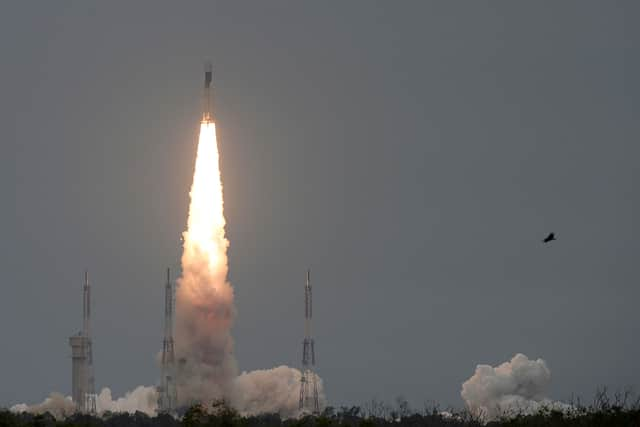Chandrayaan 3: ISRO launch time and date - India rocket launch and moon mission from Sriharikota space centre
and live on Freeview channel 276
India has launched its third Moon mission, aiming to be the first to land near its little-explored south pole. The Chandrayaan-3 craft - with an orbiter, lander and a rover - lifted off from Sriharikota space centre shortly after 10.05am BST on Friday 14 July.
The lander is scheduled to land on the Moon on 23 - 24 August, according to space officials. If successful, India will join the United States, the former Soviet Union and China as the only other nations to make a soft landing on the moon.
Advertisement
Hide AdAdvertisement
Hide AdChandrayaan-3, the third mission in India's lunar exploration programme, is anticipated to build on the accomplishments of its predecessors. Here is everything you need to know about it.
What is the Chandrayaan-3 mission?
It comes 13 years after the nation's first Moon mission in 2008, which conducted "the first and most detailed search for water on the lunar surface and established the Moon has an atmosphere during daytime," said Mylswamy Annadurai, project director of Chandrayaan-1.
The July 2019 launch of Chandrayaan-2, which also included an orbiter, a lander and a rover, was only partially successful. While the orbiter is still circling and studying the Moon, the lander-rover crashed upon touchdown since it was unable to make a soft landing. Annadurai cited "a last-minute glitch in the braking system" as the cause.
Chandrayaan-3 has the "same goals" as Chandrayaan-2, weighs 3,900kg, and cost 6.1 billion rupees (£58 million). Sreedhara Panicker Somanath, the head of the Indian Space Research Organisation (Isro), said that they have carefully examined the data from the Chandrayaan-2 mission and conducted simulated exercises to rectify the flaws.
Advertisement
Hide AdAdvertisement
Hide Ad

"The rover is carrying five instruments which will focus on finding out about the physical characteristics of the surface of the Moon, the atmosphere close to the surface and the tectonic activity to study what goes on below the surface. I'm hoping we'll find something new," Somanath told Mirror Now.
If all goes according to plan, the six-wheeled rover will roam the Moon's surface near its south pole, gathering important information and photographs that will be transmitted back to Earth for study.
The south pole of the Moon is still mostly unexplored and the darkened surface area that remains permanently in shadow there is significantly larger than that of the north pole. That means there is a greater chance of finding frozen ice water there.
"We have more scientific interest in this spot because the equatorial region, which is safe for landing, has already been reached and a lot of data is available for that," Somanath said. "If we want to make a significant scientific discovery, we have to go to a new area such as the south pole, but it has higher risks of landing."
Advertisement
Hide AdAdvertisement
Hide AdWhen will it reach the moon?
The spacecraft will enter the Moon's orbit between 15 and 20 days after lift off, with the lander scheduled to land on the Moon on 23 - 24 August. Over the following three weeks, scientists will start slowing down the rocket to a speed that will enable Vikram (the name of the lander, after the founder of Isro) to land gently.
SInce the lander and rover's batteries need sunlight to be able to charge and function, the landing will need to be "absolutely precise" to coincide with the start of a lunar day, equivalent to 14 days on Earth, Annadurai explained.
There is increasing interest in the Moon on a global scale, not just in India, and scientists say there is still much to learn about the Earth's only natural satellite, which is frequently referred to as a portal to deep space.
"The ultimate goal for India's probes is that one day when the Moon - separated by 360,000km of space - will become an extended continent of Earth," Annadurai said. "[India] will not be a passive spectator, but have an active, protected life in that continent and we need to continue to work towards that."
Advertisement
Hide AdAdvertisement
Hide AdIndia, which has nuclear weapons and is now the fifth-largest economy in the world, is eager to display its technological and security prowess under Prime Minister Narendra Modi's nationalist administration.
India is using data from space research and other fields to address issues at home. Its space programme has already contributed to the advancement of satellite, communication and remote sensing technologies, which have been applied to measure underground water levels and forecast weather.
Comment Guidelines
National World encourages reader discussion on our stories. User feedback, insights and back-and-forth exchanges add a rich layer of context to reporting. Please review our Community Guidelines before commenting.
